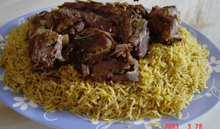 Chicken mandi | |
| Course | Lunch or dinner |
|---|---|
| Place of origin | Yemen |
| Region or state | Hadramout Region |
| Main ingredients | Rice, meat (lamb or chicken), saffron and a mixture of Hawaij[1] |


Mandi (Arabic: مندي) is a traditional dish that originated from Hadramout Region,Yemen[2]consisting mainly of meat and rice with a blend of spices, cooked in a pit. It is consumed in most areas of the Arabian Peninsula and also found in Egypt, the Levant, Turkey and Southeast Asia.


Etymology
[edit]The word "mandi" comes from the Arabic word "nada", meaning "dew", and reflects the moist 'dewy' texture of the meat.[3]
Technique
[edit]Mandi was usually made from rice, meat (lamb, camel, goat or chicken), and a mixture of spices called hawaij. The main technique that differentiates mandi from other meat dishes is that the meat is cooked in the tannour.
Dry wood (traditionally samer or gadha) is placed in the tandoor and burned to generate heat turning the wood into charcoal.
The meat is then boiled with whole spices until tender, and the spiced stock is then used to cook the basmati rice at the bottom of the tandoor. The meat is suspended inside the tandoor above the rice and without touching the charcoal. After that, the whole tandoor is then closed with clay for up to eight hours.
Regional variations and popularity
[edit]Mandi has transcended its Yemeni roots and is now popular in many parts of the Arabian Peninsula, including Saudi Arabia, the UAE, and Egypt. It is also eaten in regions such as the Levant, Turkey, and Southeast Asia, where it is known as "kuzhi mandi" in Kerala, India. Each region often incorporates local spices and cooking methods, leading to unique interpretations of the dish.
In Yemen, mandi is traditionally served on large communal platters and often accompanied by a tangy tomato sauce, known as zahawig in Yemen or dakoos in Saudi Arabia, which enhances the dish's flavors. Salatah, a fresh vegetable salad, is also commonly served alongside mandi, providing a contrast to the flavors of the meat and rice.[4][5]
See also
[edit]- Arroz con pollo
- Biryani
- Haneeth
- Kabsa
- List of rice dishes
- Maqluba
- Mansaf
- Nasi kebuli
- Pilaf
- Paella
- Quzi
References
[edit]- ^ "Chicken Mandi | Unilever Food Solutions". Archived from the original on 2019-05-09. Retrieved 2019-05-09.
- ^ Salloum, Habeeb (2012-02-28). Arabian Nights Cookbook: From Lamb Kebabs to Baba Ghanouj, Delicious Homestyle Arabian Cooking. Tuttle Publishing. ISBN 9781462905249.
- ^ "Mandi on my mind". gulfnews.com. 11 July 2013. Retrieved Jun 5, 2021.
- ^ "Chicken Mandi". cso-yemen.org. 31 July 2024. Retrieved August 8, 2024.
- ^ "Mandi: Origin Of The Rice And Meat Delicacy From Yemeni Culture". slurrp.com. 18 June 2023. Retrieved August 8, 2024.
Well, that’s interesting to know that Psilotum nudum are known as whisk ferns. Psilotum nudum is the commoner species of the two. While the P. flaccidum is a rare species and is found in the tropical islands. Both the species are usually epiphytic in habit and grow upon tree ferns. These species may also be terrestrial and grow in humus or in the crevices of the rocks.
View the detailed Guide of Psilotum nudum: Detailed Study Of Psilotum Nudum (Whisk Fern), Classification, Anatomy, Reproduction